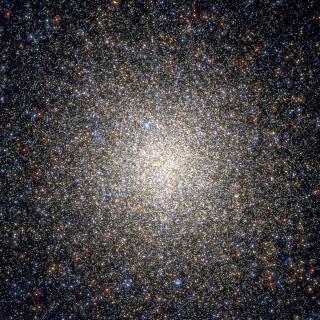Bibcode
Walker, A. R.; Kunder, A.; Iannicola, G.; Ferraro, I.; Buonanno, R.; Nonino, M.; Stetson, P. B.; Bono, G.; Bertin, G.; Monelli, M.; Varri, A. L.; Zocchi, A.; Di Cecco, A.
Bibliographical reference
The Astronomical Journal, Volume 145, Issue 4, article id. 103, 11 pp. (2013).
Advertised on:
4
2013
Citations
13
Refereed citations
10
Description
We present new number density and surface brightness profiles for the
globular cluster M92 (NGC 6341). These profiles are calculated from
optical images collected with the CCD mosaic camera MegaCam at the
Canada-France-Hawaii Telescope and with the Advanced Camera for Surveys
on the Hubble Space Telescope. The ground-based data were supplemented
with the Sloan Digital Sky Survey photometric catalog. Special care was
taken to discriminate candidate cluster stars from field stars and to
subtract the background contamination from both profiles. By examining
the contour levels of the number density, we found that the stellar
distribution becomes clumpy at radial distances larger than ~13', and
there is no preferred orientation of contours in space. We performed
detailed fits of King and Wilson models to the observed profiles. The
best-fit models underestimate the number density inside the core radius.
Wilson models better represent the observations, in particular in the
outermost cluster regions: the good global agreement of these models
with the observations suggests that there is no need to introduce an
extra-tidal halo to explain the radial distribution of stars at large
radial distances. The best-fit models for the number density and the
surface brightness profiles are different, even though they are based on
the same observations. Additional tests support the evidence that this
fact reflects the difference in the radial distribution of the stellar
tracers that determine the observed profiles (main-sequence stars for
the number density, bright evolved stars for the surface brightness).
Based in part on data obtained from the ST-ECF Science Archive Facility.
This research used the facilities of the Canadian Astronomy Data Centre
operated by the National Research Council of Canada with the support of
the Canadian Space Agency.
Related projects

Milky Way and Nearby Galaxies
The general aim of the project is to research the structure, evolutionary history and formation of galaxies through the study of their resolved stellar populations, both from photometry and spectroscopy. The group research concentrates in the most nearby objects, namely the Local Group galaxies including the Milky Way and M33 under the hypothesis
Martín
López Corredoira